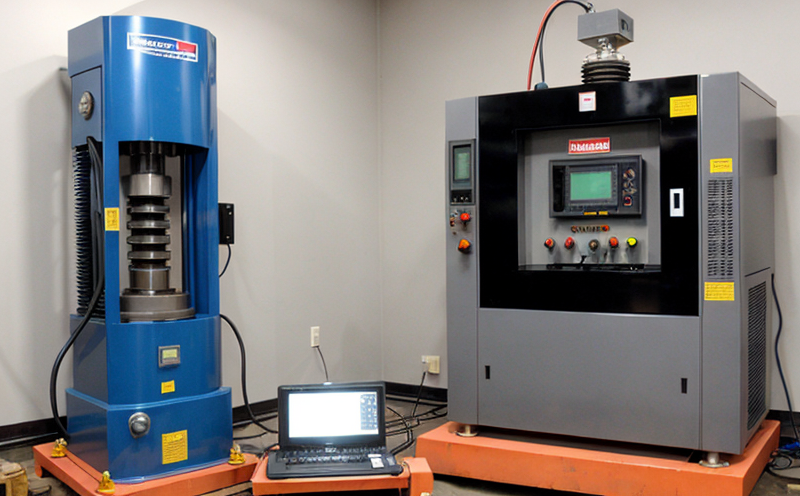Mechanical Shock Endurance Test for Industrial Electronics
The mechanical shock endurance test is a critical procedure designed to ensure that industrial electronics can withstand the physical stresses encountered in real-world environments. This test evaluates how well devices, components, and assemblies perform under sudden changes in acceleration or impact forces, which are common in industrial settings.
Industries such as automotive, aerospace, defense, and manufacturing rely heavily on robust electronic systems that must function reliably even after exposure to mechanical shocks. The test simulates the stresses these systems face during transportation, installation, operation, and maintenance.
The primary goal of this test is to provide manufacturers with a method to assess the resilience of their products against potential damage from shock events. By identifying weak points early in the design process, engineers can make informed decisions about material selection, component placement, and overall system architecture.
For instance, in automotive applications, electronic control units (ECUs) must survive road conditions that include potholes, rough terrain, and sudden stops. In aerospace, avionics must withstand launch vibrations and landing impacts. Understanding the specific environmental factors is essential for tailoring the test parameters to match real-world scenarios.
The mechanical shock endurance test typically involves applying controlled impulses of varying magnitudes and durations to a specimen or assembly. The chosen method can range from drop testing using specialized fixtures to more sophisticated systems capable of simulating complex shock waveforms.
| Method | Use Case |
|---|---|
| Drop Testing | Simulates the impact a device might experience during installation or transportation. |
| Vibration Testing | Evaluates how components behave under continuous mechanical agitation, similar to operational conditions. |
The test setup includes precise measurement instruments such as accelerometers and data acquisition systems. These tools capture vital information about the force applied, direction of impact, duration of exposure, and resulting displacement or deformation.
Specimen preparation is crucial for accurate testing results. Components to be tested should be representative of their final application form, including any associated mounting hardware if applicable. Preparing specimens correctly ensures consistent test conditions across multiple iterations.
The process involves several key steps:
- Define the shock spectrum based on industry standards or customer specifications.
- Select appropriate fixtures and mounting hardware for secure placement of the specimen.
- Calibrate all testing equipment to ensure accurate measurements.
- Perform initial runs to establish baseline data without introducing environmental variables like temperature fluctuations.
The outcome of this test provides valuable insights into a product's durability, enabling manufacturers to improve design iterations and enhance overall quality. It also helps in meeting regulatory requirements imposed by various bodies including the International Electrotechnical Commission (IEC).
Understanding mechanical shock is particularly important for industrial electronics because these products often operate in harsh environments where shocks are unavoidable. By incorporating this test into the development cycle, companies can significantly reduce warranty costs and improve customer satisfaction.
Why It Matters
Mechanical shock endurance testing is vital for several reasons. Firstly, it helps manufacturers identify potential weaknesses in their products early on, allowing them to address these issues before mass production begins. Secondly, compliance with regulatory standards like IEC 60068-2-13 ensures that products meet the necessary quality benchmarks required by various international bodies.
Furthermore, this testing enhances customer confidence and satisfaction by ensuring that industrial electronics perform consistently across different environments. Finally, it can significantly reduce warranty costs and improve product longevity in demanding applications.
International Acceptance and Recognition
- The International Electrotechnical Commission (IEC) standard IEC 60068-2-13 is widely accepted for mechanical shock endurance testing.
- This standard provides guidelines on test methods, specimen preparation, and data analysis to ensure consistency across different regions.
Compliance with these standards not only ensures that the tests are conducted consistently but also facilitates easier market entry into countries adhering to IEC regulations. This international recognition enhances the credibility of testing results and supports global trade in industrial electronics.
Use Cases and Application Examples
- Automotive industry: Testing ECU durability during transportation and installation.
- Aerospace sector: Evaluating avionics resilience against launch vibrations and landing impacts.
- Defense sector: Assessing communication devices for battlefield reliability.
| Component | Test Condition | Outcome |
|---|---|---|
| Ethernet Switch | Rapid temperature cycling with mechanical shocks | Ensures reliable data transmission in harsh environments. |
| Satellite Communication System | Vibration and shock combined | Guarantees uninterrupted communication during space launches and re-entry. |





